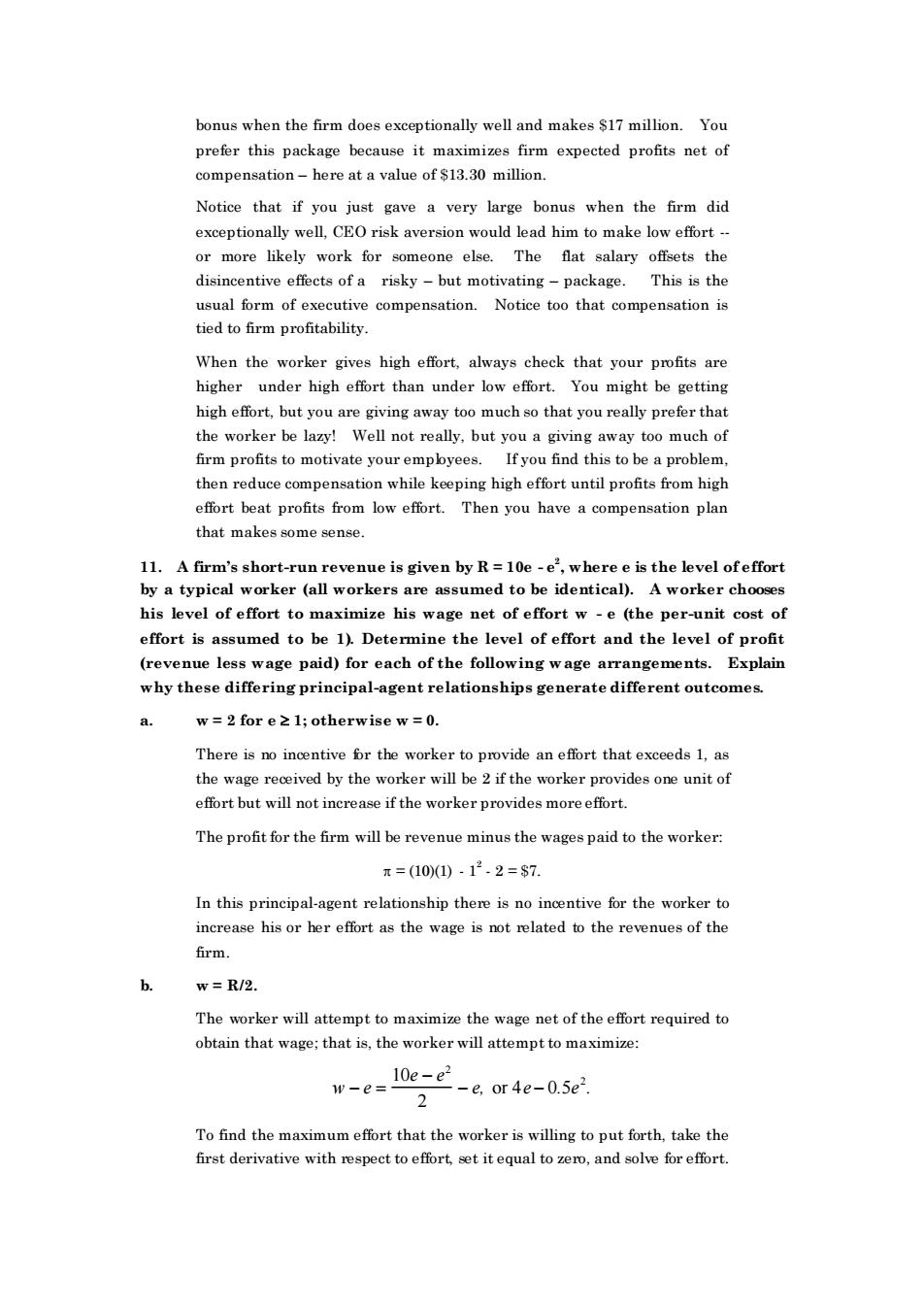正在加载图片...

bonus when the firm does exceptionally well and makes s17 million.You prefer this package because it maximizes firm expected profits net of compensation-here at a value of $13.30 million. Notice that if you just gave a very large bonus when the firm did exceptionally well,CEO risk aversion would lead him to make low effort or more likely work for someone else.The flat salary offsets the disincentive effects of a risky-but motivating-package. This is the form of ex ecutive compensation. too that c ation is tied tofirm profitability. When the worker gives high effort,always check that your profits are higher under high effort than under low effort.You might be getting high effort,but you are giving away too much so that you really prefer that the worker be lazy!Well not really.but you a giving away too much of firm profits to motivate your empbyees. Ifyou find this to be a problem then reduce com effort beat profits from low effort.Then you have a compensation plan that makes some sense. 11.A firm's short-run revenue is given by R=10e-e',where e is the level ofeffort by a typical worker (all workers are assumed to be identical).A worker chooses his level f his wage per-uniof effort is a umed to be 1).Determine the vel of effort and the level of profit (revenue less wage paid)for each of the following wage arrangements.Explain why these differing principal-agent relationships generate different outcomes. w=2 for e21:otherwise w=0. There is po incentive fr the worker to provide an effort that exceeds 1.as the wage received by the worker will be 2 if the worker provides one unit of effort but will not increase if the worker provides moreeffort. The profit for the firm will be revenue minus the wages paid to the worker =(1001.2=87 In this prineipal-agent relationship there isno inentivefor the worker to increase his or he rasthe wage to the revenues of the firm. w=R/2 The worker will attempt to maximize the wage net of the effort required to obtain that wage;that is,the worker will attempt to maximize: w-e=10e-e2 -e or 4e-05e 2 To find the that the worker is willing to put forth.take the first derivative with ect to effort t itequal toebonus when the firm does exceptionally well and makes $17 million. You prefer this package because it maximizes firm expected profits net of compensation – here at a value of $13.30 million. Notice that if you just gave a very large bonus when the firm did exceptionally well, CEO risk aversion would lead him to make low effort - or more likely work for someone else. The flat salary offsets the disincentive effects of a risky – but motivating – package. This is the usual form of executive compensation. Notice too that compensation is tied to firm profitability. When the worker gives high effort, always check that your profits are higher under high effort than under low effort. You might be getting high effort, but you are giving away too much so that you really prefer that the worker be lazy! Well not really, but you a giving away too much of firm profits to motivate your employees. If you find this to be a problem, then reduce compensation while keeping high effort until profits from high effort beat profits from low effort. Then you have a compensation plan that makes some sense. 11. A firm’s short-run revenue is given by R = 10e - e 2 , where e is the level of effort by a typical worker (all workers are assumed to be identical). A worker chooses his level of effort to maximize his wage net of effort w - e (the per-unit cost of effort is assumed to be 1). Determine the level of effort and the level of profit (revenue less wage paid) for each of the following wage arrangements. Explain why these differing principal-agent relationships generate different outcomes. a. w = 2 for e 1; otherwise w = 0. There is no incentive for the worker to provide an effort that exceeds 1, as the wage received by the worker will be 2 if the worker provides one unit of effort but will not increase if the worker provides more effort. The profit for the firm will be revenue minus the wages paid to the worker: = (10)(1) - 1 2 - 2 = $7. In this principal-agent relationship there is no incentive for the worker to increase his or her effort as the wage is not related to the revenues of the firm. b. w = R/2. The worker will attempt to maximize the wage net of the effort required to obtain that wage; that is, the worker will attempt to maximize: w − e = 10e − e 2 2 − e, or 4e− 0.5e 2 . To find the maximum effort that the worker is willing to put forth, take the first derivative with respect to effort, set it equal to zero, and solve for effort